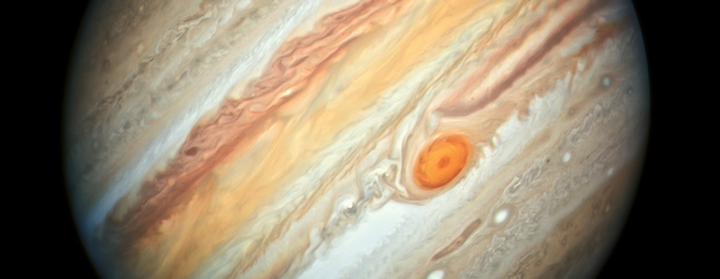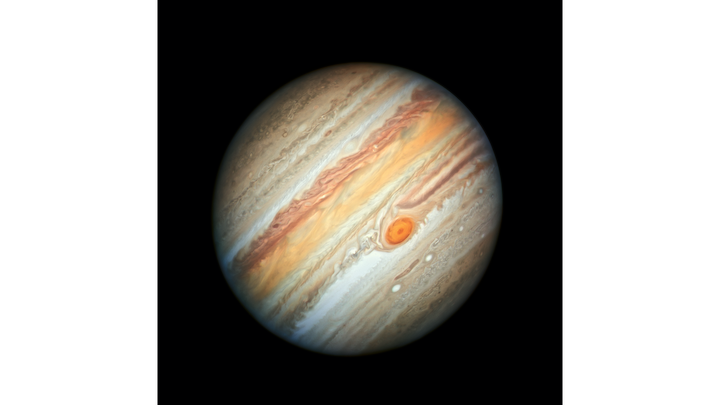9.08.2019

A CLOSE-UP LOOK AT JUPITER'S DYNAMIC ATMOSPHERE
Jupiter is the king of the solar system, more massive than all of the other solar-system planets combined. Although astronomers have been observing the gas-giant planet for hundreds of years, it still remains a mysterious world.
Astronomers don't have definitive answers, for example, of why cloud bands and storms change colors, or why storms shrink in size. The most prominent long-lasting feature, the Great Red Spot, has been downsizing since the 1800s. However, the giant storm is still large enough to swallow Earth.
The Red Spot is anchored in a roiling atmosphere that is powered by heat welling up from the monster planet's deep interior, which drives a turbulent atmosphere. In contrast, sunlight powers Earth's atmosphere. From Jupiter, however, the Sun is much fainter because the planet is much farther away from it. Jupiter's upper atmosphere is a riot of colorful clouds, contained in bands that whisk along at different wind speeds and in alternating directions. Dynamic features such as cyclones and anticyclones (high-pressure storms that rotate counterclockwise in the southern hemisphere) abound.
Attempting to understand the forces driving Jupiter's atmosphere is like trying to predict the pattern cream will make when it is poured into a hot cup of coffee. Researchers are hoping that Hubble's yearly monitoring of the planet—as an interplanetary weatherman—will reveal the shifting behavior of Jupiter's clouds. Hubble images should help unravel many of the planet's outstanding puzzles. This new Hubble image is part of that yearly study, called the Outer Planets Atmospheres Legacy program, or OPAL.

This new Hubble Space Telescope view of Jupiter, taken on June 27, 2019, reveals the giant planet's trademark Great Red Spot, and a more intense color palette in the clouds swirling in Jupiter's turbulent atmosphere than seen in previous years. The colors, and their changes, provide important clues to ongoing processes in Jupiter's atmosphere.
The bands are created by differences in the thickness and height of the ammonia ice clouds. The colorful bands, which flow in opposite directions at various latitudes, result from different atmospheric pressures. Lighter bands rise higher and have thicker clouds than the darker bands.
Among the most striking features in the image are the rich colors of the clouds moving toward the Great Red Spot, a storm rolling counterclockwise between two bands of clouds. These two cloud bands, above and below the Great Red Spot, are moving in opposite directions. The red band above and to the right (northeast) of the Great Red Spot contains clouds moving westward and around the north of the giant tempest. The white clouds to the left (southwest) of the storm are moving eastward to the south of the spot.
All of Jupiter's colorful cloud bands in this image are confined to the north and south by jet streams that remain constant, even when the bands change color. The bands are all separated by winds that can reach speeds of up to 400 miles (644 kilometers) per hour.
On the opposite side of the planet,the band of deep red color northeast of the Great Red Spot and the bright white band to the southeast of it become much fainter. The swirling filaments seen around the outer edge of the red super storm are high-altitude clouds that are being pulled in and around it.
The Great Red Spot is a towering structure shaped like a wedding cake, whose upper haze layer extends more than 3 miles (5 kilometers) higher than clouds in other areas. The gigantic structure, with a diameter slightly larger than Earth's, is a high-pressure wind system called an anticyclone that has been slowly downsizing since the 1800s. The reason for this change in size is still unknown.
A worm-shaped feature located below the Great Red Spot is a cyclone, a vortex around a low-pressure area with winds spinning in the opposite direction from the Red Spot. Researchers have observed cyclones with a wide variety of different appearances across the planet. The two white oval-shaped features are anticyclones, like small versions of the Great Red Spot.
Another interesting detail is the color of the wide band at the equator. The bright orange color may be a sign that deeper clouds are starting to clear out, emphasizing red particles in the overlying haze.
The new image was taken in visible light as part of the Outer Planets Atmospheres Legacy program, or OPAL. The program provides yearly Hubble global views of the outer planets to look for changes in their storms, winds, and clouds.

Hubble's Wide Field Camera 3 observed Jupiter when the planet was 400 million miles from Earth, when Jupiter was near "opposition" or almost directly opposite the Sun in the sky.
Quelle: NASA
